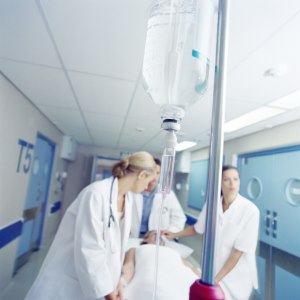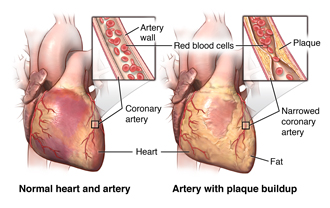Heart Attack
What is a heart attack?
A heart attack (myocardial infarction,or MI happens when one or more areas of the heart muscle don't get enough oxygen. This happens when blood flow to the heart muscle is blocked.
The blockage is caused by a buildup of plaque in the arteries (atherosclerosis). Plaque is made up of depositsof cholesterol and other substances. When a plaque breaks (ruptures), a blood clot quickly forms. The blood clot is the actual cause of the heart attack.
If the blood and oxygen supply is cut off, muscle cells of the heart begin to suffer damage and start to die. Irreversible damage begins within 30 minutes of blockage. The result is heart muscle affected by the lack of oxygen no longer works as it should.
Who is at risk for a heart attack?
There are two types of risk factors for heart attack.
| Inherited (or genetic) | Acquired |
|
Inherited or genetic risk factors are risk factors you are born with that can't be changed. They can be improved with medicine and lifestyle changes. |
Acquired risk factors are caused by activities that a person chooses to do. These can be managed through lifestyle changes and medical care. |
Inherited (genetic) factors: Who is most at risk?
These groups are most at risk:
-
People with inherited high blood pressure (hypertension)
-
People with inherited low levels of HDL cholesterol, high levels of LDL cholesterol, or high levels of triglycerides
-
People with a family history of heart disease. This is especially true if the heart disease started before age 55.
-
Older men and women
-
People with type 1 diabetes
-
Women who have gone through menopause. Generally, men are at risk at a younger age than women. After menopause, women are equally at risk.
Acquired risk factors: Who is most at risk?
These groups are most at risk:
-
People with acquired high blood pressure (hypertension)
-
People with acquired low levels of HDL cholesterol, high levels of LDL cholesterol, or high levels of triglycerides
-
Cigarette smokers, including chewing tobacco and electronic cigarettes (e-cigs or vaping)
-
People who are under a lot of stress
-
People who drink too much alcohol or use illicit drugs such as cocaine
-
People who lead a sedentary lifestyle
-
People who are overweight by 30% or more
-
People who eat a diet high in saturated fat and low in fiber
-
People with type 2 diabetes
A heart attack can happen to anyone. When you take the time to learn which risk factors apply to you, you can take steps to eliminate or reduce them.
Managing heart attack risk factors
Here are ways to manage your risks for a heart attack:
-
Look at which risk factors apply to you, then take steps to eliminate or reduce them.
-
Learn about high blood pressure and high cholesterol levels. These may be "silent killers." Newer medicines are available to treat people with familial hypercholesterolemia (inherited high cholesterol), called PCSK9-inhibitors. Ask your healthcare provider if these medicines would be right to help prevent a heart attack.
-
Change risk factors that aren't inherited by making lifestyle changes. Talk with your healthcare provider to find out how to do so.
-
Talk with your healthcare provider to find out if you have risk factors that can't be changed. These can be managed with medicine and lifestyle changes.
What are the warning signs of a heart attack?
The following are the most common symptoms of a heart attack. But each person may have slightly different symptoms.
-
Severe pressure, fullness, squeezing, pain, or discomfort in the center of the chest that lasts for more than a few minutes
-
Pain or discomfort that spreads to the shoulders, neck, arms, or jaw
-
Chest pain that gets worse
-
Chest pain that doesn't get better with rest or by taking nitroglycerin
-
Chest pain that happens along with any of these symptoms:
-
Sweating, cool, clammy skin, or paleness
-
Shortness of breath
-
Nausea or vomiting
-
Dizziness or fainting
-
Unexplained weakness or fatigue
-
Rapid or irregular pulse
-
Although chest pain is the key warning sign of a heart attack, it may be confused with other conditions. These include indigestion, pleurisy, pneumonia, tenderness of the cartilage that attaches the front of the ribs to the breastbone, and heartburn. Always see your healthcare provider for a diagnosis.
Responding to heart attack warning signs
If you or someone you know has any of the above warning signs, act right away. Call 911, or your local emergency number. Do not drive yourself to the hospital or emergency department if you think you are having a heart attack.
Treatment for a heart attack
The goal of treatment for a heart attack is to relieve pain, restore blood flow to the coronary artery, preserve the heart muscle function, and prevent death.
Treatment in the emergency department may include:

-
IV (intravenous) therapy, such as nitroglycerin and morphine
-
Continuous monitoring of the heart and vital signs
-
Oxygen therapy to improve oxygenation to the damaged heart muscle
-
Pain medicine to decrease pain. This, in turn, decreases the workload of the heart. The oxygen demand of the heart decreases.
-
Cardiac medicine such as beta-blockers to promote blood flow to the heart, improve the blood supply, prevent arrhythmias, and decrease heart rate and blood pressure
-
Fibrinolytic therapy. This is the IV infusion of a medicine that dissolves the blood clot, restoring blood flow.
-
Antithrombin or antiplatelet therapy with aspirin, heparin, and/or clopidogrel. This is used to prevent further blood clotting.
-
Antihyperlipidemics. These medicines lower lipids (fats) in the blood, particularly low density lipid (LDL) cholesterol. Statins are a group of antihyperlipidemic medicines. They include simvastatin, atorvastatin, pitivastatin, fluvastatin, lovastatin, rosuvastatin and pravastatin. Bile acid sequestrants—colesevelam, cholestyramine, and colestipol—and nicotinic acid (niacin) are 2 other types of medicines that may be used to lower cholesterol levels.
You may need other procedures to restore blood flow to the heart. Those procedures are described below.
Coronary angioplasty
With this procedure, a balloon is used to create a bigger opening in the vessel to increase blood flow. This is often followed by inserting a stent into the coronary artery to help keep the vessel open. Although angioplasty is done in other blood vessels elsewhere in the body, percutaneous coronary intervention (PCI) refers to angioplasty in the coronary arteries. This lets more blood flow into the heart. PCI is also called percutaneous transluminal coronary angioplasty (PTCA). There are several types of PTCA procedures:
-
Balloon angioplasty. A small balloon is inflated inside the blocked artery to open the blocked area.
-
Coronary artery stent. A tiny coil is expanded inside the blocked artery to open the blocked area. The stent is left in place to keep the artery open.
-
Atherectomy. The blocked area inside the artery is cut away by a tiny device on the end of a catheter.
-
Laser angioplasty. A laser used to "vaporize" the blockage in the artery.
Coronary artery bypass
This surgery is most commonly referred to as simply bypass surgery or CABG (pronounced "cabbage"). It is often done in people who have chest pain (angina) and coronary artery disease. Coronary artery disease is when plaque has built up in the arteries. During the surgery, the surgeon makes a bypass by grafting a piece of a vein above and below the blocked area of a coronary artery. This lets blood flow around the blockage. The surgeon usually takes veins from a leg, but he or she may also use arteries from the chest or an arm. Sometimes, you may need more than one bypass surgery to restore blood flow to all areas of the heart.



